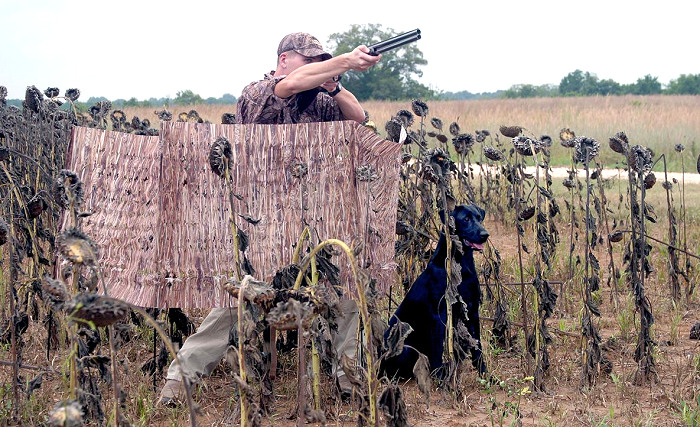The Backcountry Press
The country's premier daily HUNTING, FISHING & OUTDOOR news in the USA and around the globe. Read whats happening in your neck of the woods & beyond.
The Backcountry Outdoor News reports the latest hunting and, fishing news along with fishing derbies and tournaments
from:
| ||||||
| ||||||
|
HUNTING NEWS CATEGORIES
© 2010 Backcountry Press Outdoor News - All Rights Reserved Website Design by:
Connect With Us
 | ||||
Disclaimer: The views expressed on this site are that of the authors and not necessarily that of TBC Press
 | ||||
Ten Rules to Help Avoid Hunting Dog Disasters - Continued
Submitted by: TBC Press
Posted on: 02/13/20
7. Gun Safety
There is no way to stop a shot charge or bullet from exiting the barrel once the trigger is pulled. Dogs and people are inadvertently shot every season through careless and not-so-careless gun handling. Being totally aware of the surroundings before the trigger is pulled is vital.
Waterfowl hunters need a set of rules established before the hunt is underway. Retrievers are susceptible to being shot primarily when chasing cripples, so guidelines need to be set regarding that situation. The simplest rule to live by is don’t shoot when a dog is on retrieve. In most cases, the dog’s owner should be the only hunter dispatching a cripple.
This puts all the responsibility on the person most likely to be very careful with the shot. Retrievers should be steady to shot before ever entering a hunt. Repeat, the only safe dog is a steady dog!
Article-A20-2137-P2
6. Eyes
The same stuff that can cut skin can harm eyes too. Hard-charging dogs seldom slow up the way humans do in the face of brush. They run in with reckless abandon. Limbs whipping by, brushy sloughs, even high grass can irritate an eye.
Fortunately, in most cases eye injuries are not serious. That doesn’t’ mean that a cornea can’t be scratched, or an eyeball punctured. There are dog goggles available if risk of eye problems is extremely high. Keep a bottle of eye wash handy and flush the eye when a problem is encountered. Head to the vet if irritation persists.
Upland dogs also need to be steady to shot to minimize the chance of injury from gun fire. Be completely sure that the dog or dogs are clear before taking the shot, and never shoot a crippled bird on the ground unless the dog handler orders you to.
8. Running Multiple Dogs
The more dogs on a hunt, the more chances for accidents. Upland hunters often run multiple dogs and duck and goose hunters use two to three dogs working together on occasion. Running dogs together is all about the level of training they have received. Older, more experienced, and steady dogs are fun to hunt together. Young dogs need work on their own with handlers focused on their performance.
Upland dogs must be able to back and honor the first dog on point. Period. A dog that is working on its own and not trained to respect the other dogs will disrupt a fine day afield. This point cannot be stressed enough: A hunt is not the time to train. Repeat, hunting is NO time for training. The groundwork for a quality dog must be laid in controlled environments and not in the unpredictable world of the hunt.
9. Nutrition
Working dogs need good food in the right quantities for optimum performance. A general guideline is 30 percent protein and 20 percent fat in the food fed to working dogs. Problems arise when dogs are overfed and underworked. That leads to health problems related to the dog being overweight and/or not in prime condition.
It is hard to feed a dog too much when it’s training and hunting on a regular basis. Those calories are needed for the energy required for strenuous activity. Upland breeds running hard for miles need more than retrievers bringing back 10 birds in a morning. Use common sense, and make sure the food is providing all the nutrients needed. Cut back to a maintenance feed with less protein and fat in the offseason unless the dog is training often.
10. The Wash Out
A peril that no one likes to talk about is a dog not making the grade. Otherwise known as “washing out,” the dog doesn’t have the drive and talent for the job at hand. That means different things to different people. Field trialers expect the highest level of skill and anything less is not acceptable. Many field-trial washouts make excellent hunting dogs.
Others are looking for a good field dog, one that can handle the basics with at least some level of style. The word “meat dog” is used a lot to describe hunting dogs with basic skills. As in the dog is “bringing back the meat.”
It can be tough to turn a dog you thought was going to be a stud (and you paid a bundle of money for) into a pet, but sometimes, they just don’t make the grade. If the dog shows fear or complete lack of desire, then it’s time to move on. When that time happens depends on the dog. Often it’s a question of maturity. One day the “light bulb” goes on and the dog gets it. Don’t give up until it appears the dog doesn’t want to be there no matter what is tried. Then it’s time to punt.
Article and Image courtesy of Outdoor Life
####















